CTIA's Love/Hate Relationships with Both SF and Unlicensed
We have written several times about CTIA’s love/hate relationship with unlicensed spectrum and about its generally negative view towards San Francisco - ruling it off limits for any future CTIA meeting and suing it over the city’s attempt to make sure customers have basic information about cell phone safety - information similar to that now available on the website of the Swiss EPA and similar to the text that CTIA’s French counterpart supplies for inclusion with every new cellphone and SIM sold in France.
So imagine your blogger’s surprise when he found this paid content on the Washington Post website:
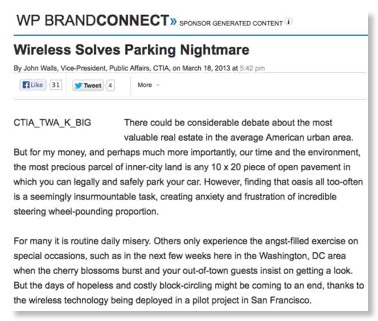
CTIA’s ever quotable John Walls even says
San Francisco’s SF Park initiative uses wireless sensors in city parking spaces and garages to inform city drivers where they can park, thereby reducing congestion, saving time, and lowering greenhouse gas emissions.
Nice words from CTIA about SF!!! Well it certainly is a wireless system and it certainly is in San Francisco, but as we noticed in an April post on CTIA’s boasting about a “wireless” system for farmers, it appears that unlicensed is a key part of the system.
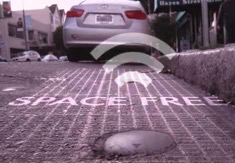
In reality unlicensed and cellular systems have a real synergy. But CTIA endlessly seems to oppose any new unlicensed spectrum and appears to have been the force behind the ill fated “unlicensed auction” House bill that was drafted by a former CTIA staffer.
MS Spectrum Observatory: Seeing Things NTIA Doesn't Want to See
In August 2010 we published a post here entitled “Does NTIA Have the Bureaucratic Courage to Measure Occupancy of 225-400 MHz?” At the time we used the following chart to show bands NTIA had measured and publicly reported on and the middle band they had carefully ignored.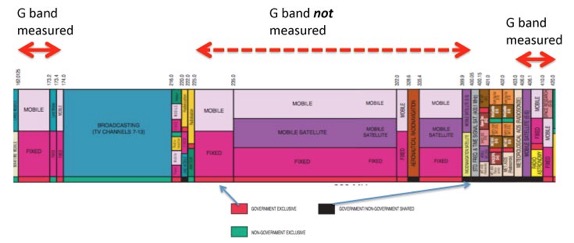
The 225-400 MHz band is home to many federal systems, but is best known for military aircraft communications. In other countries it is used for civilian aircraft communications and in countries where the US has bases, e.g. Japan and NATO countries, there is tenuous sharing. A fact of US geography is that with the notable exception of San Diego there are no large military airfields in major cities. Thus in geography military spectrum use in this band is generally orthogonal to civil needs for spectrum - that is you rarely see a heavy demand for both military aircraft spectrum and civil spectrum users in the same place.
Long time readers may recall that your blogger has been advocating “interruptible spectrum” use here for a long time. Interruptible spectrum is similar to interruptible electricity. One has access to the resource, but can be preempted from time to time when there is great demand for the resource from users with higher priority.
If your view of cellular communications is people calling 911 then this doesn’t make much sense. But all voice communications is a shrinking faction of cellular traffic and 911 traffic must be microscopic. The great growth in demand for mobile broadband is basically for discretionary services, not safety related services. While the cellular community would like to guarantee all users a high quality of service, there frankly isn’t the spectrum available to do so. Other utilities offer pricing schemes to affect demand with approaches like peak pricing in addition to offering interruptible service at a discounted price. The cellular industry just hasn’t been thinking this way.
But similarly NTIA has not been thinking “out of the box” about efficient use of the natural resource at 225-400 MHz despite new White House thinking. The June 14, 2013 Presidential Memorandum -- Expanding America's Leadership in Wireless Innovation stated:
“Although existing efforts will almost double the amount of spectrum available for wireless broadband, we must make available even more spectrum and create new avenues for wireless innovation. One means of doing so is by allowing and encouraging shared access to spectrum that is currently allocated exclusively for Federal use. Where technically and economically feasible, sharing can and should be used to enhance efficiency among all users and expedite commercial access to additional spectrum bands, subject to adequate interference protection for Federal users, especially users with national security, law enforcement, and safety-of-life responsibilities.”
Does 225-400 MHz meet this test of economic and technical feasibility? The lack of official data on its occupancy discourages commercial interest. (Of course the cellular industry’s impossible goal of only getting spectrum that is available 24/7 in all US territory and can use Chinese-made electronics also discourages interest .) There has been some data available in public reports from Shared Spectrum for several years. (See Note 1 below)The following plot was in an early post here.
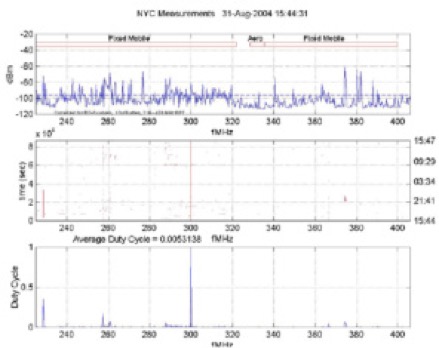
In case the August 2004 date doesn’t ring a bell, this data was taken during the 2004 Republican Convention in New York City 3 years after 9/11 when an unprecedented federal law enforcement and military presence was there to protect national leaders. The third plot shows that spectrum use in 225-400 MHz was negligible despite this high federal presence. Other Shared Spectrum publicly available measurements are at their website and show a similar pattern.
There is also data available from the IIT Spectrum Observatory in Chicago which has been making observations since 2007 and storing them. Unfortunately there is not a simple way for researchers to access this data without making detailed arrangements with IIT.
We recently became aware of another resource, the Microsoft Spectrum Observatory which makes observation between 30 and 6,000 MHz in Brussels, Redmond, Seattle, and Washington DC. Unlike the IIT measurements, these are available for online access to anyone!
So how busy is 225-400 MHz in Washington DC and Seattle? In the 2 charts below I picked for the whole day of 1/21/13 in DC, the day of President Obama’s second inauguration and an exceptionally high federal presence. In the case of Seattle I picked 6/4/13, a day I happened to have been there for a conference which I recall was a bright warm sunny day unlike what one expects in Seattle.
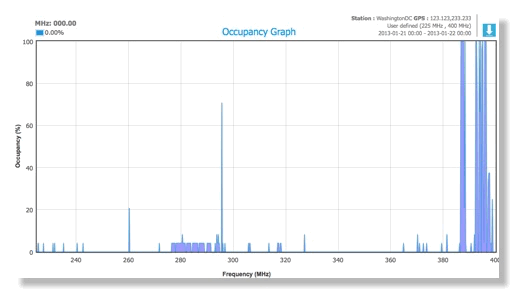
Spectrum Occupancy Washington DC 1/21/13 24 hour data (225-400 MHz)
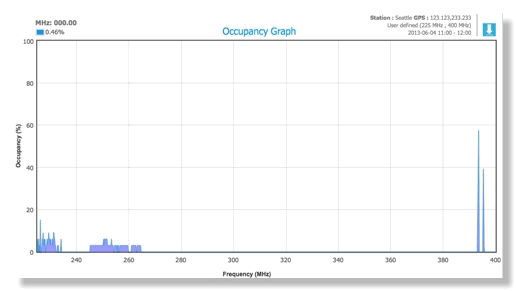
Spectrum Occupancy Seattle WA 6/4/13 1100-1200 (225-400 MHz)
So the cellular industry is not interested in this band because it wants 24/7 nationwide access and the ability to use Chinese-made electronics that meet global standards. Why isn’t FCC and NTIA interested? Repeatedly the problem I hear is that it would complicate the job for DoD spectrum managers stationed overseas who have to explain to our allies why dedicated military channels are needed in this band. The fear is that if DoD doesn’t need 24/7 access to this band in the US, why do they need access in Japan and Europe? This is a real issue but I think it is time to stop holding US spectrum use hostage in order to simplify the job of DoD spectrum managers overseas. The issue here is not reallocating this spectrum to 24/7 commercial use and not using it for 5GHz-like “dynamic spectrum access” that depends on sensing, but rather have a dynamic database system that updates cellular base station in real time which frequencies can be used on a fail-safe basis. Normally base station would have access to much of the band, but as military traffic start building up in an area, blocks would be cleared in anticipation of more traffic so the military traffic would always have what it need plus an additional block of spectrum for rapid surges.

Note 1: There is no detailed generally accepted way to measure occupancy so it is impossible to make precise comparison of measurements. Many decisions have to be made before data is collected and those decisions affect the numbers. Some possible decisions increase apparent occupancy, some decision decrease it. I vividly recall climbing Mt. Fuji in Japan about 15 years ago with my trusty 2m amateur radio. At the top of 12,388' (3,776 m) Mt. Fuji all amateur radio frequencies in the 2m band are fully occupied since the radio horizon includes most of the main island of Honshu! Similarly sensitivity/noise figure, filtering, and 3rd order intercept point decisions affect apparent occupancy. But that said, measurements with very low occupancy show that there is a real issue that should be investigated to confirm or deny whether spectrum is available. Note also that spectrum occupancy measurements usually miss satellite uplink and some downlink transmissions due to their nature. Measurements of full duplex bands with base stations also tend to see the base station downlinks and due to siting can miss the corresponding uplink traffic.
Note 2: How might 225-400 be shared with the private sector? It is clear that any use mobile-based spectrum sharing decision system is not secure enough for the national security uses of this band. Also no listen-before-talk (LBT) cognitive radio system would be reliable enough either. But a base station-based system, typical in today’s cellular systems would place the spectrum selection system in the hands of a few carriers. The carrier spectrum election system could then in turn be controlled in a fail/safe way by DoD spectrum managers to make sure that at a given moment the spectrum is adequate to handle at least (100 + x)% of the authorized DoD traffic. As the DoD traffic approaches the amount set aside for them at a given time in a given area the amount set aside should be increased to maintain a positive margin of available spectrum above demand. Some may argue that the physics of this sharing is similar to the 1755-1850 MHz sharing considered by NTIA’s CSMAC. The D/U ratios discussed there were computed using a primitive propagation that IRAC prefers because it is very conservative. A more balanced consideration of sharing issues under the terms of the 6/13 Presidential Memo would likely give differing answers.
UPDATE
See http://www.marcus-spectrum.com/Blog/files/SpecMeasCorr414.html
How Many Homes Really Watch Over the Air TV?
New NAB/CEA Feud
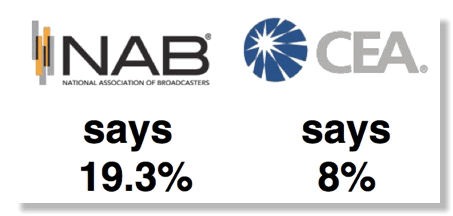
They can’t both be right!
Remember a few years ago when CEA and NAB were cooperating in 2008-9 with each other to facilitate the DTV transition? Wasn’t that nice? Two industries sharing their toys like nice little children. Only a little earlier in 2005 they were accusing each other of things like “Perpetuating a Fraud on Consumers”. Well, they are back at each others’ throats again! The telecom bloggers of the USA thank both for this gift. Now that Jon Stewart is back, we hope he can benefit from it also.
On June 21, 2013 NAB announced that
New research from GfK Media & Entertainment shows that the estimated number of Americans now relying exclusively on over-the-air (OTA) television broadcasting increased to 59.7 million, up from 54 million just a year ago. The percentage of TV households currently OTA reliant has now grown from 14% in 2010 to 19.3% in the current survey, a 38% increase in just four years. The recently completed survey also found that the demographics of broadcast-only households continue to skew toward younger adults, minorities and lower-income families.

We're one of the world’s leading research companies. Every day, our 12,000+ experts discover new insights into the way people live, think and shop in over 100 countries. We use the latest technologies and smartest methodologies to help our clients deeply understand the most important people in the world: their customers.
Sounds a lot more credible than some blogger, doesn’t it?
But then only 9 days later, NAB’s former partner in DTV transition, CEA, announced
The CEA report was designed and formulated by CEA Market Research, “the most comprehensive source of sales data, forecasts, consumer research and historical trends for the consumer electronics industry” with “90+ years of research history” - GfK is only 79 years old, founded in Nuremberg, Germany in 1934. (Perhaps it isn’t fair to say so, but Leni Riefenstahl’s Triumph of the Will was filmed in Nuremberg in 1934 -- in case the date and location sound familiar. “By general consent [one] of the best documentaries ever made.” -- Roger Ebert)New research released today from the Consumer Electronics Association (CEA) ® found that just seven percent of American TV households rely solely on an antenna for their television programming. The findings of the new study, U.S. Household Television Usage Update, are consistent with CEA’s 2010 research which found eight percent of TV households reported using an antenna only for television programming. According to historical CEA research, there has been a gradual decline in the percentage of TV households using antennas since 2005. The phone survey of 1,009 U.S. adults is comparable to a 2012 Nielsen study indicating nine percent of all U.S. TV households are broadcast TV/over-the-air only, a decrease from 16 percent in 2003.
The only publicly available details on the study cited by NAB in an entry in the GfK blog entitled “Confessions of a Cord Cutter Skeptic Revisited”. By contrast, CEA would be glad to sell you a copy of their whole study ($399 if costs matter, no cost to CEA members).
But the issue here is critical to the pending incentive auction and the whole question of the spectrum needs of TV broadcasting. So this is too important a question to leave to CEA/NAB finger pointing! So in the interest of closure on this issue here is:
A Suggestion to Resolve This Key Disagreement: For at least 2 decades FCC has been paying Census Bureau for quarterly telephone penetration surveys which have been noncontroversial since Census is viewed by all as unbiased on this issue. This data collection is now part of the he Current Population Survey (CPS), sponsored jointly by the U.S. Census Bureau and the U.S. Bureau of Labor Statistics (BLS). Just last Thursday, WSJ reported on the the latest survey and found that “more than a quarter of U.S. households have ditched landline phones”. Significant changes in consumer behavior result from pricing changes and technology changes.
Since the issue of OTA market share is critical for the incentive auction, why doesn’t FCC pay Census to track both OTA home penetration as well as telephone penetration? I suspect that the cost would be allowable as part of the expenditures to support the incentive auctions and thus need not come from the very limited FCC appropriated budget.
Efficient Use of Government Spectrum Act of 2013: NTIA Will Regret Its Silence on AWS-3

CEA immediately praised the new bill with its president and CEO Gary Shapiro, saying:
“This legislation represents an important effort in reallocating our nation’s valuable spectrum for wireless broadband, while raising much-needed funds for the U.S. Treasury. The 1755-1780 MHz band represents key spectrum that our nation’s innovators need to deploy robust mobile broadband networks for the benefit of all Americans.”
Similarly Tim McKone, AT&T Executive Vice President of Federal Relations, said
“AT&T commends Congresswoman Matsui and Congressman Guthrie for introducing legislation that would free up spectrum that is critically important for the wireless industry. While AT&T continues to work with federal agencies and industry on potential spectrum sharing scenarios of government-held spectrum, the economic benefits of an exclusive licensing framework cannot be denied. The wireless industry has invested billions of dollars in infrastructure under this framework. Making the 1755 MHz to 1780 MHz spectrum available for commercial mobile broadband use will not only spur additional investment but will further help fund our nationwide public safety network.”
Oddly, T-Mo, the most obvious beneficiary of this action has been silent to date.
[Note even though AT&T and CEA are praising the new bill, the text is not yet available to mortals such as us. A visit to THOMAS, the Library of Congress website for “the rest of us” at the time of this writing returns the following message:
“The text of H.R.2739 has not yet been received from GPO “]
But this brings to mind NTIA’s silence curing the M2Z/AWS-3 struggle in which M2Z Networks, a former MSS client, sought to solve the idle status of the 2155-2180 MHz band by using it for time division duplex (TDD) operation and leave the federal users in the lower band alone. This proposal was vilified by the cellular industry in general, except for Sprint which was supportive of TDD, and was the subject of a 4.5 year FCC deliberation that was never resolved on either the technical or nontechnical issues pending. Indeed, it ended with a phone call from an FCC staffer to M2Z’s main investor that said though even though over 4 years had elapsed FCC couldn’t decide. The Commissioners never voted on the issue.
NTIA was silent during this proceeding and now probably regrets this silence. Because had NTIA been supportive of the technical issues involved and helped show that careful TDD use of 2155-2180 MHz could have protected T-Mo from its own foolish decision to use handsets made for the European band plan for the US market, NTIA could have helped protect federal users from the hurried expulsion from this band that will result from the new bill. NTIA routinely meddles in FCC spectrum rule makings and, as was mentioned previously here, often uses vagaries of the FCC’s ex parte rules to hide its tracks.
But NTIA probably did want to rile the cellular establishment at the time so they sat idly by while TDD use of the upper band was attacked by almost everyone. Now the hens are coming home to roost and federal users should ask how they got into this hole -- something that was perfectly predictable.
UPDATE
A few days after this post, DoD threw in the towel and agreed to vacate the 1755-1780 MHz band. But, FierceWireless adds:
“However, it's unclear how workable the Pentagon's new offer of a compromise will be. The DoD said that it will cost about $3.5 billion to move its operations out of the spectrum. According to the Wall Street Journal, the Pentagon plans to compress much of its operations into the 1780-1850 MHz band, and will also move some of its operations to the 2025-2210 MHz band, which is currently used by TV broadcasters. However, the Pentagon left many details up in the air, including a timetable for moving off the 1755-1780 MHz band.”
As we pointed out in February, SECDEF Hagel had experience in the cellular industry, -- a point most of the other media outlets missed. While I don’t think Sec. Hagel favored his old comrades over national security, he probably was the first SECDEF to ask the right questions about the military’s voracious appetite for spectrum and about whether this was the band to fall on your sword for Maybe we see more in his memories in 10 years.
The text of HR 2739 is now available for “the rest of us”.
GigaOM: Is Cisco stacking the deck with its mobile data numbers?
To hear Cisco tell it, the world is quickly running out of wireless spectrum. Tim Farrar, of TMF associates, says a look at the numbers shows that Cisco first overstated them, then revised them, and is now overstating them again.
The Cisco mobile VNI forecast (the shorthand for Visual Networking Index: Global Mobile Data Forecast) is widely used as a justification for specific amounts of new mobile spectrum.
For example on p. 76 of the National Broadband Report it says,
According to Cisco, North American wireless networks carried approximately 17 petabytes per month in 2009,7 an amount of data equivalent to 1,700 Libraries of Congress. By 2014, Cisco projects wireless networks in North America will carry some 740 petabytes per month, a greater than 40-fold increase.
A search on “Cisco” in this report gives 50 uses, although some are duplicates involving their URL.
In a recent FCC filing a few days before the GogaOM post CTIA said
These findings by CTIA bear out the numerous expert projections regarding mobile data traffic:
-Cisco’s Visual Networking Index (“VNI”) projects wireless data traffic in 2016 will be 16 times the volume of traffic in 2011, and 100 times the volume of traffic in 2009.9 This projection involves traffic on licensed spectrum alone, taking into account the off-load of other wireless traffic onto unlicensed spectrum. Thus, Cisco’s VNI projections demonstrate the pressure solely on licensed spectrum.
The GigaOM post points out discrepancies between Cisco’s projections and CTIA’s own reporting of actual traffic:
Nevertheless, at least in the U.S. we can attempt to validate Cisco’s numbers, given that CTIA’s mobile data traffic statistics are based on direct reporting by carriers accounting for 97 percent of wireless connections in the U.S.. In its latest forecast, Cisco estimates that mobile data traffic in the U.S. was 128PB/month in December 2011, and increased to 207PB/month by December 2012.
However, CTIA data indicates that 633PB were carried in the first six months of 2012, for an average of 105.5PB each month. Cisco’s estimate for the U.S. is clearly inconsistent with the CTIA statistics: It is hardly likely that monthly traffic declined significantly between December 2011 and June 2012, and equally implausible that total mobile data traffic in the U.S. then doubled in the second half of the year.
Now spectrum needs are different than traffic projections. Spectrum needs depend critically on infrastructure buildout and technology used. There is not a fixed conversion factor from petabytes to MHz.
A key issue for the cellular industry is which is more cost-effective: acquiring additional spectrum or building out infrastructure to the maximum possible. Of course, acquiring spectrum is a good way to assure long term market hegemony for a given carrier, something mere infrastructure buildout does not assure.
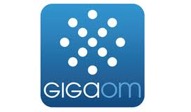



![Validate my RSS feed [Valid RSS]](valid-rss-rogers.png)

